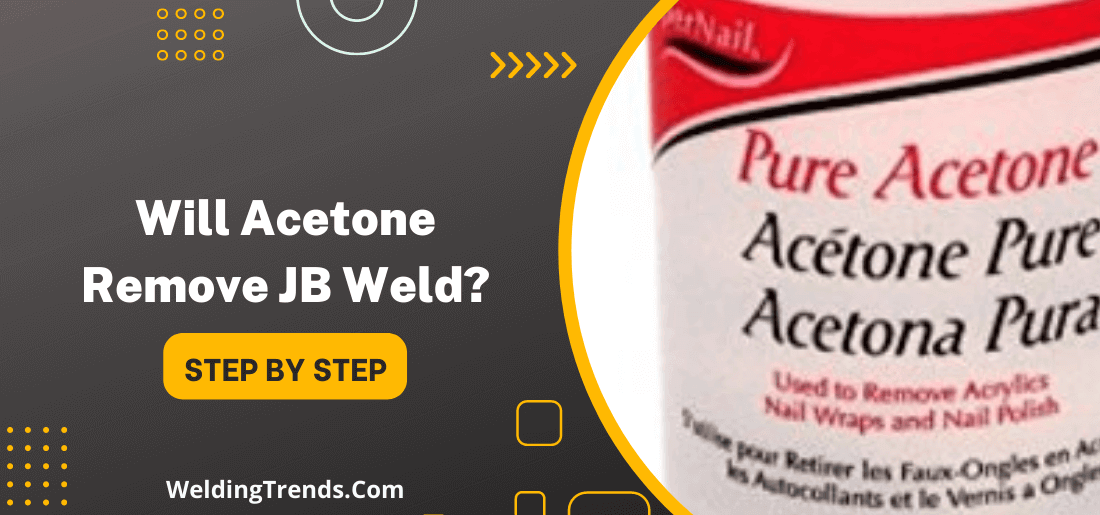If you’ve ever had to fix something around the house, you’ve probably used JB weld. JB weld is a popular, strong adhesive for fixing metal parts together.
But what happens if you need to remove it? Some people say that acetone will do the trick but does it work?
In this blog post, we’ll take a look at the feasibility of using acetone to remove the JB weld. Read on to learn more!
What is JB weld and what are its uses?
JB weld is a two-part epoxy that can be used for a variety of purposes including repairing metal parts. It’s strong and durable, making it a popular choice for repairs.
However, the JB weld can be difficult to remove once it has been applied. It contains two parts, a hardener and a resin. When these two parts are mixed, they create a strong bond that can be difficult to break.
Will acetone remove the JB weld?
Acetone is a common solvent that can be used to remove a variety of substances, including JB weld. However, it’s important to note that acetone will only work if the JB weld is still in its liquid form.
Once the JB weld has hardened, acetone will not be able to penetrate it and will not be effective. So, it is important to make sure that you act quickly if you want to remove the JB weld with acetone.
How to remove the JB weld with acetone? Step By Step
If you’re planning on using acetone to remove the JB weld, there are a few things you should keep in mind.
- First, only use acetone if the JB weld is in liquid form.
- Second, use a clean cloth or paper towel to apply the acetone. Acetone is a powerful solvent and can damage surfaces if it’s not used properly.
- Third, give the acetone a few minutes to work before wiping it away. After a few minutes, the JB weld should start to soften and can be easily removed.
- Fourth, if the JB weld is still stubborn, you can try using a putty knife or other sharp object to scrape it off. However, be careful not to damage the surface underneath.
- Fifth, once the JB weld has been removed, you should clean the area with soap and water to remove any residue.
As you can see, acetone can be used to remove the JB weld. If you follow these tips, you should be able to remove the JB weld without any problems.
pros and cons of using acetone to remove JB weld
Following are the pros of using acetone to remove JB Weld:
- It is a strong solvent that can dissolve most types of glue, including JB Weld.
- Acetone is relatively safe to use.
- It dries quickly.
- It evaporates quickly, so there is no need to worry about it damaging the surface beneath the JB Weld.
There are some cons to using acetone as well, however:
- Acetone can be harmful if inhaled in large quantities.
- It is also a strong irritant, so it can cause skin and eye irritation.
- If not used properly, acetone can damage some types of plastic.
- Acetone is also flammable, so it should be used with caution around open flames.
In general, acetone is a good option for removing JB Weld. It is important to use it properly, however, to avoid damaging the surface beneath the weld or causing harm to yourself.
Alternatives to acetone for removing JB weld
Acetone is a powerful solvent that can be used to remove the JB weld, but it is not the only option. Other solvents that can be used to remove JB weld include isopropyl alcohol, denatured alcohol and mineral spirits.
When using any of these solvents, it is important to take precautions to avoid inhaling the fumes or coming into contact with the skin. It is also important to dispose of the used solvent properly.
If you are looking for a more environmentally friendly option, some solvents are made from natural ingredients. These include citrus-based solvents and soy-based solvents.
some risks associated with using acetone to remove the JB weld
- Acetone is a very flammable solvent and can easily catch fire if exposed to an ignition source.
- Acetone can also be harmful if inhaled or ingested, so it is important to use proper ventilation when working with it.
- If the JB weld is not completely removed, it can leave behind a residue that can be difficult to remove and may cause problems if the area is painted or coated.
- It is also important to make sure that all of the JB welds are removed before applying any new coatings or paints, as it can interfere with the adhesion of these products.
- As well as the risks associated with removing the JB weld, there is also the potential for damaging the surface that you are working on. Acetone can dissolve some types of plastics, so it is important to test it on a small area before using it on the main project.
- It is also worth noting that acetone will remove any grease or oil from the surface, so it is important to clean the area thoroughly before starting work.
Overall, acetone is a very effective solvent for removing JB weld, but it is important to be aware of the risks involved before using it. If used correctly, it should not cause any problems, but it is always best to err on the side of caution.
If you are unsure about using acetone, or if you have any concerns, then it is always best to speak to a professional before starting work.
How can you safely remove the JB weld without using acetone or any other harsh chemicals/solvents?
One way to safely remove the JB weld is to heat it with a soldering iron. This will cause the JB weld to soften and you should be able to easily remove it.
Another way is to use a chisel or utility knife to slowly scrape away the JB weld. Be careful not to damage the surface beneath.
If you need to remove the JB weld from a sensitive surface, you can try using WD-40 or another lubricant. Apply the WD-40 and let it sit for a few minutes before slowly wiping away the JB weld.
Also, if you are trying to remove the JB weld from something hard to reach, you can try using a hairdryer. Heat the JB weld until it is soft and then slowly remove it with a putty knife or another tool.
FAQs – Will acetone remove JB weld?
Does alcohol dissolve J-B Weld?
Yes, alcohol will dissolve J-B Weld. However, J-B Weld is not designed to be dissolved and will not work as intended once it has been mixed with alcohol. If you need to remove J-B Weld from a surface, we recommend using a razor blade or sandpaper.
Is there anything that dissolves J-B Weld?
Yes, there are a few solvents that can dissolve J-B Weld, but they are quite harsh and can be dangerous to use. The most common solvents used are acetone, methylene chloride and toluene. These solvents should only be used by experienced professionals in well-ventilated areas.
Is JB Water Weld permanent?
JB Water Weld is a permanent solution for your leaking problems. It will not only stop the leaks, but it will also prevent any future leaks from happening.
JB Water Weld is made with a special formula that makes it resistant to high temperatures and pressures, so it can withstand anything your plumbing system throws at it. Plus, JB Water Weld is backed by a lifetime warranty, so you can be confident that your repairs will last.
Can you paint over J-B Weld?
J-B Weld can be painted over once it has healed. Curing time is dependent on temperature and humidity, but it typically takes around 24 hours for the repair to reach full strength. Once J-B Weld has healed, it can be sanded, drilled, tapped, machined and painted.
How do you break J-B Weld?
J-B Weld can be difficult to remove once it has been cured, but there are a few methods that can be used to break the bond. One way is to use a chisel or sharp knife to score the surface of the J-B Weld, then apply heat with a torch until the material becomes soft enough to remove.
Another method is to use a chemical stripper, which will need to be applied several times to break down the J-B Weld. Once the bond is broken, the J-B Weld can be removed with a putty knife or sandpaper.
Wrap Up
So, will acetone remove the JB weld? The answer is yes! Acetone is a powerful solvent that can quickly break down the adhesive properties of JB weld.
Be sure to test this method in a small area first to make sure it doesn’t damage the surface you’re working on. Acetone is a powerful solvent that can quickly dissolve many materials, but it is also very harsh.
Make sure to use it in a well-ventilated area and take all necessary safety precautions. If you’re not comfortable using acetone, other solvents can be used to remove the JB weld, such as methylene chloride or toluene.




